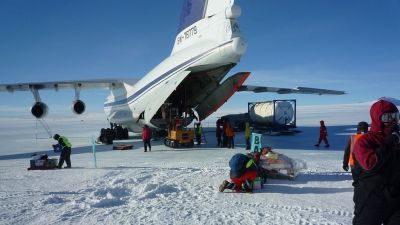
Scientists arrive at station as season enters full swing
The 2014-15 season is in full swing now that the first batch of scientists have finally arrived. The new arrivals get acquainted with life at the station and go for crevasse training.
A tiring journey
Having left Cape Town late Tuesday evening on a red-eye to Antarctica, the scientists, doctor, journalist, field guide and teacher from the Polar Quest contest arrived at the Russian Novolazarevskaya (“Novo”) station on the coast of East Antarctica in the early morning hours of Wednesday, November 19th.
With such a large group of new arrivals and lots of scientific equipment to transport, it was necessary to take two separate connecting flights to the Princess Elisabeth station. Part of the group flew to the Princess Elisabeth late Wednesday afternoon, while the remainder stayed behind to spend a night at Novo before taking the next available flight on Thursday morning.
An emotional return
Belgian journalist Jos van Hemelrijck, who had last seen the Princess Elisabeth station in 2008 when it was still being built on Utsteinen Ridge, was part of the first group who arrived on Wednesday evening.
“We arrived at Princess Elisabeth yesterday night with a first feeder flight from Novo in a party of seven, which included the young scientists, the doctor Jacques Richon, and Roger Radoux, the Polar Quest teacher,” Jos recalled. “It was a happy moment to return to Utsteinen after six years. I confessed to Jaques that it was quite an emotional moment for me. He said the first sight of this place when you arrive throws him time after time.”
Welcoming the new arrivals
Now that all the scientists have arrived, the station is in full swing for the season! The staff is working long hours to make up for the time lost when the first crew was delayed for nearly a week in Cape Town.
Alain welcomed the new arrivals with a briefing on daily life and how things work at the station. Living with several other people at a remote research station where energy and water use must be optimized takes some getting used to. Things need to work like clockwork in order to have a smooth living experience at the station.
Crevasse training
On Thursday afternoon, field guide Raphael "Raphie" Richard and doctor Jacques Richon led a field training exercise where they took the newcomers to a crevasse zone 7 km away from the station. Crevasses are deep cracks in the upper layer of the ice sheet that form naturally from as the ice sheet flows. They are a potential hazard, especially if a person falls into a deep one. Knowing how to identify a crevasse and rescue someone from it is essential knowledge when working in Antarctica.
During the training, InBev-Baillet Latour laureate Jan Lenearts got to play the injured victim as Dr. Richon demonstrated the procedures for taking care of someone once they had been rescued from falling into a crevasse. There was some excitement when Polar Quest teacher Roger Radoux and Icecon scientist Brice van Liefferinge got a bit of extra real-world training, when the block pulling them out of the crevasse broke. However as all precautions possible are taken during the training and both were well secured, they were not in any danger. But it was a good learning experience, as it reminded them of the importance of taking extra precautions in a place like Antarctica.
Field expeditions to start soon!
Soon the scientific field expeditions will be heading out to the plateau and the coast. Their equipment, transport and food supply are being readied for departure on Tuesday of next week, weather permitting.
Over the next few weeks, we'll talk to some of the scientists to learn more about the fascinating research they're working on this season.
Picture: Unloading cargo at Novo station - © International Polar Foundation / Jos van Hemelrijck
